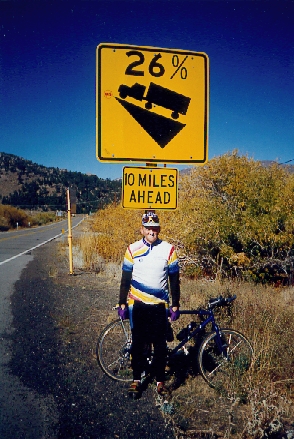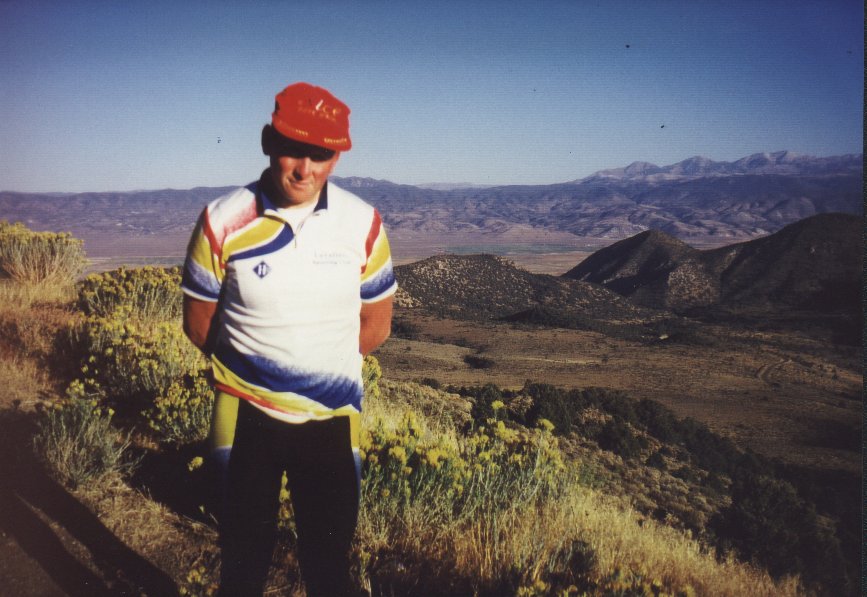

In October, 1999, Charly, my French cycling partner, accompanied me to California.
Charly belongs to the Club des 100 Cols, a French-based organization that includes members from other countries. To qualify for membership, you must have ridden at least 100 “cols” (passes) considered official by this organization. For every 100 cols, five must be higher than 2000 meters. Finding enough 2000 meter cols to satisfy the requirements means travelling to foreign countries, as well as riding unpaved roads. Charly's goal is to be in the top 10, in terms of the number of passes ridden. At the end of 1998, he was 13th. At the end of 1999, he was 10th (as of December, 1999 he had 3441 passes, 201 of which are higher than 2000 meters).
Below is my translation of his report for the Revue des 100 Cols.
October, 1999, the dead leaves begin to fall, the temperature drops in our dear old country. The end of the season is near, rather favorable for relaxing, but, as is my habit, a third trip abroad seems necessary.
An American friend suggests that I go with her to her (former) home in California, at the other end of the world. At first, I am suspicious—I imagine the beach, the casinos, Pamela Anderson, Hollywood, etc...
Just the opposite—after landing at San Francisco and savoring its sights, we make a hop of 300 km east in a rental car—one can appreciate the American automobile lobby. The California mountains are in view, an immense barrier called the Sierra Nevada and, sometimes even, the California Alps. The sky is a luminous blue and the temperature hot: in short, Indian summer.
Several kilometers from Lake Tahoe—the largest mountain lake in the United States, the second in the world for altitude (1890 meters), and the preferred vacation spot for Californians because of its casinos—we abandon the car for a short time to climb a pass, roughly speaking. Five kilometers of climbing, rather steep, not “the sea to drink” therefore, but difficult after a long trip and jet lag! Within the first few meters, we feel the lack of oxygen; the air is dry and it takes us several days to become acclimated. The top of Echo Summit (2250 meters) is hostile to cyclists because it is on a main highway, so we don’t linger there.
Retracing our steps to the car, we go next to the town of Markleeville (1678 meters), a place typical of the American west, in the heart of a national park. From here, we will make several trips by... bicycle, crossing the neighboring passes, all higher than 2000 meters. For our lodging, a simple motel is sufficient; but it is expensive, and I had to bargain for a price reduction, a practice not usually followed here.
The next day, blue sky, a cold temperature congeals us, for the thermometer is below 0 degrees C (32 degrees F) during the night, but the sun quickly raises the temperature to 25 degrees C (78 degrees F). In the car, we rejoin the start of our course—encountering a coyote who is not startled—and then attack the first pass on a smooth surface, which we appreciate: 200 meters of elevation for 4.5 km, and rapidly, the summit of Luther Pass (2361 meters) is in view. Without waiting, we descend and start the next climb. The view is sometimes only so-so, but appreciable, and the trees are a glittering autumn yellow. The traffic is fluid and the emergency shoulder allows us to ride in peace. The summit approaches; Barbara, my riding partner, leaves me behind (she spins to take my breath away); Carson Pass culminates at 2612 meters. From summer clothes for the climb, winter clothing is better for the 9 km descent to Lake Caples, with its sparkling water reflecting the sun. Next, a short climb of 3 km to pick up Carson Spur (2434 meters), at the edge of a gigantic canyon. Turning back with, once again, Carson Pass, to conclude the 60 km ride with three “2000”.
During the evening, the village is excited because a young bear makes a remarkable appearance: it does the round of garbage cans without upsetting anyone except the dogs.

The following days, to finish a well-ventilated week, we cross nine more “2000”, one of which is Sonora Pass (2941 meters), the highest road pass in California, the most dreaded climb for cyclists (would I be afraid with my 22x28 without saddlebags?). A changeable countryside, no traffic, and percentages that are sometimes terrifying (road sign indicating 26% at Sonora Pass).
Charles WINTER No. 1835
de LEVALLOIS-PERRET (Hauts-de-Seine)
Return to Bicycling à la Française